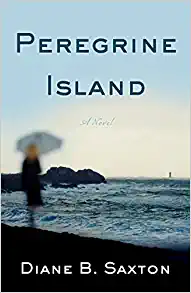Peregrine Island by Diane B. Saxton
Complex and rich, Peregrine Island: A Novel is a story where each character beautifully intertwines with the next, helping to create a narrative that is filled with art, mystery, family and life. The author of Peregrine Island, Diane B. Saxton, previously worked as a journalist, covering everything from animal rights activism, to travel and everything in between.
In an exclusive BookTrib interview, Saxton talks to about the inspiration behind her novel and writing about women in this day and time when women’s leadership has taken center stage.
BookTrib: Where did your inspiration to write this novel stem from?
DS: That’s a very good question. The main reason I love to write fiction is because I honestly don’t know where stories originate. It’s an amazing thing for me to come up with ideas I didn’t know I had. Of course the kernels of ideas always come from somewhere. In this case they came from my love of the Sound and from my interest in art—from a painting I admire. I wondered why the artist painted that particular subject and wondered if he knew the people in the painting and, if so, how and who they were.
BookTrib: How has your work as a journalist influenced your work as a novelist?
DS: I think a writer’s craft is ever evolving, that you can always learn something new. As a journalist I had editors who for the most part corrected and improved my writing: sentences, paragraphs, content. I was also given the gift of discipline and perseverance. Both I really didn’t get in school. Deadlines and finding and holding on to topics. I can usually tell immediately if the author of a novel comes from that world, because the book is usually organized— not necessarily outlined— and very well written.
BookTrib: How does nature, specifically the Long Island Sound, play a role in the novel’s progress?
DS: I lived on Long Island Sound for many years and grew to respect it in almost a spiritual way The ocean, the Sound became an illuminating experience for me. Every day was different. When I looked out into the waves, the sky above it, when I felt the wind, its breath. When I tasted its salt, it was hypnotizing. My desk faced the water, which I thought would be stupendous, but I had to lower the shades in order to work. The Sound previewed the weather. It was the weather. I was afraid of it yet I was awed by it. By its beauty and its continuous movement. It was alive; it breathed.
I tried to describe the moods of the Sound in conjunction with the characters’. Contemplative, stormy, calm, beautiful and more beautiful, bright, grey yet always moving, changing. Just like the moods of the characters. As it changed for the better so did the lives of the characters’.
BookTrib: Why did you decide to make the three women characters so different from one another?
DS: I thought it would easier to describe them, to show the reader how they weren’t so different after all.
BookTrib: Was there significance for writing in the voice of women?
DS: There is actually no significance. The novel came out that way. When I started to write the book the characters came alive, from where I honestly can’t say. This is why I love fiction. The three characters would never have been male.
Yet my next book, is told through the eyes of a family with two sons and along with the mother is mostly told in their voices.
BookTrib: You talk about the seen and the unseen. How does it contribute to the family’s development?
DS: Henry David Thoreau said that “Most men live lives of quiet desperation and go to the grave with their song still in them.”
Winter and Elsie, an old man on the beach befriended by Peda, and the three men who have arrived on the island with such an unnatural interest in the painting that it begins the mystery in the first place, are all transformed.
Because unlike Thoreau I don’t believe that it’s most men or women, just a great many of them. Who hasn’t wished that his or her life had taken a different turn? I’ll bet that neither Winter nor Elsie expected that their lives would end up in the way they have. Disappointed but unwilling to change — due to fear, to inertia, or simply because they didn’t know how. They didn’t “see” it.
Whether we know it or not, unlike Thoreau, I believe that the human spirt is always searching for ways to overcome dissatisfaction or unhappiness— consciously, unconsciously, or even subconsciously.
In the case of this island family, isolated from social interaction and the mainland by water, the mystery of the heirloom painting provides a conduit for change. Is this fate? Maybe just a coincidence, or is it will? Or a combination there of?
BookTrib: Why does Winter use painting to distract herself from her family?
DS: She lives in her imagination, in the life she has made up for the people in the painting. Their lives take her away from the unhappiness and lack of satisfaction of and in her own life.
BookTrib: How do secrets affect the relationship between the Winter, Elsie and Peda?
DS: Their secrets keep each one at arms’ length. Even Peda, with her secrets with Jake, her secrets with the crabs she helps, give her the life she craves; they give her the love she lacks within her family. With Winter the secrets of the people in the painting, and with Elsie her time after college in Vermont with the man who fathered her child. Of course there are other secrets because one secret builds upon another and yet another. And stretches Winter, Elsie, and Peda away from each other, pulling them farther and farther apart.
BookTrib: How does the presence of the detectives change the family dynamic?
DS: When the detective(s) arrive the family members begin in earnest to judge and accuse one another. Outside influences tend to squelch the status quo. When this family was isolated not much changed in their lives. When the detectives came on the scene, everything changes, rocking their viewpoints of the world, of their own lives, of each other.
Peregrine Island: A Novel is now available for purchase.
Buy this Book!
Amazon




